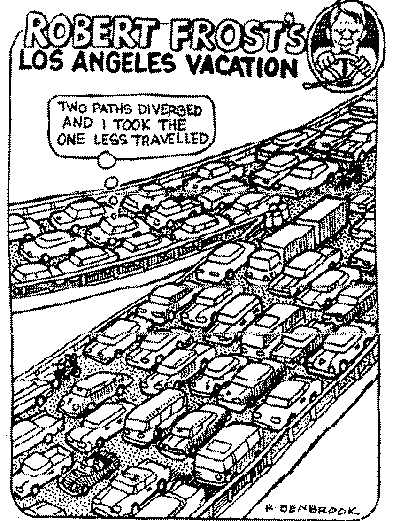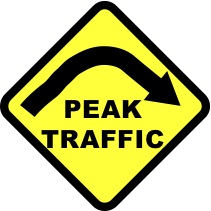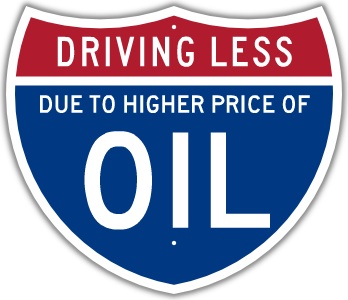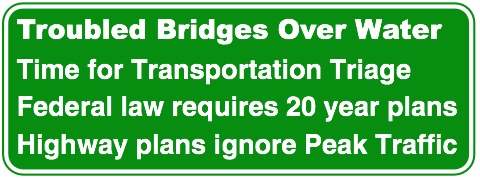Road Scholar Dictionary and Acronyms
Transportation Bureaucracy Acronyms
 "The great enemy of clear language is insincerity."
"The great enemy of clear language is insincerity."
-- George Orwell
4(f) - Section 4(f) of the 1966 Transportation Act
ACOE - Army Corps of Engineers
CE - Categorical Exclusion
CEQ - Council on Environmental Quality
CFR - Code of Federal Regulations
DEIS - Draft Environmental Impact Statement
DOT - Department of Transportation
EA - Environmental Assessment
EIS - Environmental Impact Statement
EPA - Environmetnal Protection Agency
FEIS - Final EIS
FHWA - Federal Highway Administration
FONSI - Finding of No Significant Impact
GPS - Global Positioning System
LOS - Level of Service (ranges from A to F)
LUTRAQ - Land Use, Transportation, Air Quality
LWCF - Land and Water Conservation Fund
MPO - Metropolitan Planning Organization
NEPA - National Environmental Policy Act
P&N - Purpose and Need
RFID - Radio Frequency Identification
ROD - Record of Decision
SDEIS - Supplemental Draft EIS
SFEIS - Supplemental Final EIS
UGB - Urban Growth Boundary
USC - United States Code
V/C - Volume to Capacity ratio (congestion measurement)
VMT - Vehicle Miles Traveled
Dictionary
Alternatives: the range of options studied in an Environmental Impact Statement.
brownfield: an area slated for "development" that has previously been used for other purposes, usually applied to abandoned industrial areas with contamination problems. The euphemism for building commercial or residential development in natural areas not previously paved over is "greenfield."
Categorical Exclusion: a waiver granted to federal projects with de minimus (too small to be of importance) environmental and social impacts.
collaborator: a word that has two meanings, one nice, one not. It is used extensively by greenwashers who bring together developers and government agencies on one side, and alleged environmentalists on the other in a grossly unequal effort to discuss "win-win" solutions that result in controversial highways getting approved. Cooperation is a nicer word which only has a positive meaning but it is rarely used by public relations professionals.
cooperating agency: A government agency that uses another agency’s Environmental Impact Statement as the basis for their own decision. The National Environmental Policy Act requires that cooperating agencies participate in the full process of scoping of alternatives, followed by draft EIS, public comments and final EIS before a Record of Decision can be issued.
cumulative impact: the impact on the environment which results from the incremental impact of the action when added to other past, present, and reasonably foreseeable future actions regardless of what agency (Federal or non Federal) or person undertakes such other actions. Cumulative impacts can result from individually minor but collectively significant actions taking place over a period of time. (40 CFR 1508.7) Most Environmental Impact Statements do not examine cumulative impacts on natural ecosystems, highway budgets, or traffic patterns.
customer: a euphemism used by some government agencies to describe citizens
Environmental Assessment: a smaller study than an EIS, it is used to determine whether a proposed project would have significant impacts that must be analyzed in an EIS, or if not, the impacts can be dismissed in a "Finding of No Significant Impact."
Environmental Impact Statement: a report mandated by the 1970 National Environmental Policy Act to examine the consequences of federal actions upon the natural and built environments. The sequence of an EIS starts with developing a Purpose and Need (to identify a problem), Scoping of Alternatives, a Draft EIS, a public hearing and comment period, review of public input, and finally a Final EIS and a Record of Decision by the agency. If major problems are identified during the Draft phase, new circumstances arise that were not identified, or a major change to the project is made, the agency can be required to issue a Supplemental EIS (which needs to follow the same process as an EIS, except a new P&N and Scoping are not required).
Federal Highway Administration (FHWA): Part of the U.S. Department of Transportation, the FHWA is the government agency that makes the "Record of Decision" for a federally funded road project and what efforts must be made to "mitigate" the imapcts. FHWA is the main agency that is sued to block road approvals if federal funds are used and/or if a Federal Highway decision must be made (for example, a new interchange on an interstate highway). Local referendums and City Council decisions do not determine federal transportation policies.
geoslavery: the use of Global Positioning System (GPS) technology to keep track of everyone, all the time. GPS, RFID chip enabled drivers licenses (national IDs), cell phones and other electronic surveillance systems (finances, communication, internet, etc) combined together could create a totalitarian state more intrusive than any previous dictatorship.
greenwash (noun, verb): The false claim of environmental protection, usually made by serious polluters with an image problem. Also, campaigns made to further such false claims. synonym: Smart Growth.
highwaymen: 1. persons who rob travelers on a road
(from Webster’s dictionary)
2. politicians and bureaucrats who demand that taxpayers given them money
to build a road
impact: A euphemism for "destroy" ("the Modified Project will impact 6.4 hectares of high value wetlands")
improvements: A euphemism employed by highway promoters. Synonyms: road widening, highway construction.
independent utility: a FHWA requirement that highway projects be a reasonable expenditure even if no additional transportation improvements in the area are made. FHWA states that "as long as a project will serve a significant function by itself (i.e., it has independent utility), there is no requirement to include separate but related projects in the same analysis." See "segmentation."
indirect effects: caused by the action and are later in time or farther removed in distance, but are still reasonably foreseeable. Indirect effects may include growth inducing effects and other effects related to induced changes in the pattern of land use, population density or growth rate, and related effects on air and water and other natural systems, including ecosystems.
40 CFR § 1508.8 Effects includes ecological (such as the effects on natural resources and on the components, structures, and functioning of affected ecosystems), aesthetic, historic, cultural, economic, social, or health, whether direct, indirect, or cumulative. Effects may also include those resulting from actions which may have both beneficial and detrimental effects, even if on balance the agency believes that the effect will be beneficial.
interchange: A grade-separation of two or more highways that allows more traffic at greater speeds than a traffic light controlled intersection. Interchanges are much more expensive than merely building roadway.
intersection: An at-grade junction of two or more roads.
ISTEA: Intermodal Surface Transportation Efficiency Act of 1991. The highway bill passed during the President George H. W. Bush administration. ISTEA established the High Priority Corridors list, a massive list of new and expanded interstate highways. It also required including multimodal components to new and expanded road projects. State Departments of Transportation also were required to have a pedestrian / bicycle coordinator.
Land and Water Conservation Fund: a federal program for purchasing significant natural habitats for preservation, lands bought with LWCF money cannot be used for other purposes (such as highway construction).
logical termini: FHWA requirement that highway projects are of sufficient length to have independent utility. FHWA defines logical termini as "(1) rational end points for a transportation improvement, and (2) rational end points for a review of the environmental impacts. The environmental impact review frequently covers a broader geographic area than the strict limits of the transportation improvements. ... the most common termini have been points of major traffic generation, especially intersecting roadways." (The Development of Logical Project Termini, FHWA report)
LUTRAQ: Land Use, Transportation and Air Quality. A study conducted in Portland, Oregon that found that an expanded light rail system, modest work to existing roads and land-use shifts to make communities more public transit oriented would reduce traffic congestion and pollution compared to the Western Bypass (now canceled). Parsons, Brinkerhoff, one of the LUTRAQ contractors, is a major highway construction consultant.
mileage tax: a proposal for replacing gasoline taxes with charges for the distance motorists drive. Since part of the gas taxes are State based, a simple reading of a car's odometer would not work. Mileage taxes would require using electronic surveillance to track where each car travels so each State would only charge for miles in each state. Proponents are trying to trick environmentalists into supporting this Homeland Security system by suggesting it would discourage excessive driving. However, merely increasing gasoline taxes would be a fairer approach. Charging more at the pump would not only charge people more who drive more but would also charge people who drive inefficient vehicles more than those who drive more efficient cars. Driving slower and less aggressively would also cost less than speeding above the speed limits (since driving faster can use more fuel per unit distance traveled).
Moving Ahead for Progress in the 21st Century Act was passed in 2012, the Obama adminstration's highway law. It only extends funding for two years, unlike the usual six year appropriations of previous highway laws (ISTEA, TEA-21, SAFETEA-LU). Like SAFETEA-LU, it further restricts legal review of highway approvals.
National Environmental Policy Act of 1969 (NEPA): Federal law that governs the approval of major Federal actions, including federal-aid highway construction and Army Corps of Engineers wetland destruction permits. NEPA is the law that mandates Environmental Assessments (for projects that lack "significant impact") or Environmental Impact Statements (for large projects). NEPA prohibits segmenting a large project into smaller pieces to avoid disclosing impacts. NEPA is a procedural law that requires disclosure of environmental damage, it does not require minimization by choosing the option with the least damage.
National Highway System Designation Act of 1995 was not the periodic transportation appropriation legislation. Instead it designated lots of roads as priority routes, changed bureaucratic designations of Interstates and other primary roads, made changes to the way funds are distributed, abolished Federal speed limits and prohibited Federal spending on highway signs that have both US and metric measurements.
no-build alternative: a NEPA requirement that all proposed actions must be compared with.
parkway: Traditionally, a roadway of two or four lanes with increased forest buffer to reduce visual and noise impacts on nearby neighborhoods. Parkways do not allow truck traffic and may or may not be completely limited access (ie., some parkways have traffic lights and at-grade intersections). In recent years, this word has lost most of its meaning since numerous superhighway projects are now called Parkways even though trucks are permitted. This word is central to campaigns to persuading uncertain citizens that highways are compatible with natural ecosystems.
Peak Oil: the all time maximum rate of extraction of petroleum, as charted on a curve. All oil fields have a roughly bell curve shaped rate of production – the initial extraction is of oil that is under pressure and is easiest to extract, but once half of the oil is removed, retrieving the remaining supplies becomes much more difficult. The only debate among petroleum geologists about the precise timing of the global peak of petroleum production is exactly when it will occur, and how fast extract rates will decline – the reality of Peak Oil is not seriously disputed by experts in the field. Most of the debate is between geologists who think we are currently near, or at, the global peak, and those who think it is later in this decade or slightly into the next decade (the official US Geological Survey position is that the global peak is still about three decades away, still in most of our lifetimes but close enough to be an immediate crisis). The peak of oil discoveries worldwide was four decades ago, around 1962. The peak of oil discoveries in the United States was in the 1930s, about four decades before the peak of production in 1970. Much of the theoretical basis for analyzing Peak Oil was performed by the geologist M. King Hubbert in the mid-1950s, who accurately predicted the US would peak around 1970 and that the global peak would come around 2000. Control of the world's remaining supplies will determine who will control the global economy in the coming decades.
purpose and need: a statement that provides justification for a federal action that will be analyzed by an EIS or EA (the first stage of the NEPA process). Any alternative from a citizens' group that seeks to invalidate an agency's preferred option must demonstrate that it meets the project's purpose and need.
record of decision: the final part of an EIS process, whereby a Federal agency approves its preferred alternative. A federally funded highway cannot be litigated in Federal court until the ROD has been signed, since before that point in the decision making process the proposed road is merely a consideration, no decision has formally been made.
Radio Frequency Identification (RFID): radio-frequency identification, a new technique for massive tracking of nearly everything on Earth. An RFID chip is about the size of a grain of rice, and contains a small transmitter that emits an 18 digit identification number when a particular wavelength of radio energy is aimed at it (it is a totally passive system, no battery or other internal power source is needed). RFID chips are sought by large grocery stores to replace bar codes, which would enable tracking of individual objects to a much greater degree of precision (RFID chips would keep track of each individual bottle of shampoo, bar codes merely identify that shampoo bottle as a particular brand). RFID chips are planned for credit cards, paper currency, drivers licenses, car tires, grocery store products, and are even being implanted under the skin of people in experimental trial runs. A global surveillance society based on RFID chips would be far more intrusive than any previous dictatorships, far outstripping the police states of Nazi Germany, Stalinist Russia or Apartheid South Africa.
SAFETEA-LU: Safe, Accountable, Flexible, Efficient Transportation Equity Act: A Legacy for Users was the highway bill passed in 2005, George W. Bush's highway law. It roughly doubled highway construction funds over the previous TEA-21. SAFETEA-LU gutted some of the legal requirements for highway approvals, most notably imposing a six month limit for challenging Federal Highway Administration Record of Decisions. Reportedly, the "Lu" in the the acronym was a reference to the wife of the House Transportation Chair Don Young (R-Alaska).
scope: the NEPA process where the range of alternatives are developed for detailed study in an EIS or EA
from 40 CFR § 1508.25: Scope consists of the range of actions, alternatives, and impacts to be considered in an environmental impact statement. The scope of an individual statement may depend on its relationships to other statements (§§1502.20 and 1508.28). To determine the scope of environmental impact statements, agencies shall consider 3 types of actions, 3 types of alternatives, and 3 types of impacts. They include:
(a) Actions (other than unconnected single actions) which may be:
(1) Connected actions, which means that they are closely related and therefore should be discussed in the same impact statement. Actions are connected if they:
(i) Automatically trigger other actions which may require environmental impact statements.
(ii) Cannot or will not proceed unless other actions are taken previously or simultaneously.
(iii) Are interdependent parts of a larger action and depend on the larger action for their justification.(2) Cumulative actions, which when viewed with other proposed actions have cumulatively significant impacts and should therefore be discussed in the same impact statement.
(3) Similar actions, which when viewed with other reasonably foreseeable or proposed agency actions, have similarities that provide a basis for evaluating their environmental consequences together, such as common timing or geography An agency may wish to analyze these actions in the same impact statement. It should do so when the best way to assess adequately the combined impacts of similar actions or reasonable alternatives to such actions is to treat them in a single impact statement.
(b) Alternatives, which include:
(1) No action alternative.
(2) Other reasonable courses of actions.
(3) Mitigation measures (not in the proposed action).(c) Impacts, which may be:
(1) Direct;
(2) indirect;
(3) cumulative.
Section 4(f): A section of the 1966 Transportation Act that prohibits Federal highways through parks, wildlife refuges and historic properties unless there are no "prudent and feasible" alternatives. Section 4(f) requires that agencies consider avoidance before mitigation of impacts. These alternatives may include shifting a highway alignment or adopting a different land use and transportation policy instead of a new highway, as was done in Portland, Oregon.
segmentation: the National Environmental Policy Act of 1969 prohibits "segmentation" of a large Federal project into segments to avoid full disclosure of adverse environmental and/or social impacts. see independent utility.
Smart Growth: a term first used in 1996 by the Governor of Maryland, Parris Glendening. It promotes accelerating urbanization in urban areas and inner suburbs that generally vote Democratic as opposed to outer suburbs and rural areas that generally vote Republican. Glendening's "Smart Growth" law directed State subsidies and infrastructure spending to designated growth areas, which included incorporated cities and the area inside the Capital and Baltimore Beltways.
At the time, Glendening was having difficulty getting his prized Intercounty Connector superhighway approved (part of the original Washington Outer Beltway plan). "Smart Growth" permitted "connector roads" between designated growth areas, so the ICC, which connected the cities of Gaithersburg and Laurel, was allowed under this law. New football stadiums for the Washington Redskins and Baltimore Ravens also qualified for public subsidies even though the Redskins stadium moved that football team from a location directly on a Metrorail station to a farm in the suburbs where the nearest Metro was much further away.
Smart Growth might have been a good idea around 1950, but now that we have passed the limits to growth on a finite planet it is merely a marketing slogan to greenwash the image of real estate speculators.
stakeholder: "a person entrusted with the stakes
of bettors" (Webster's Dictionary)
2. A euphemism employed by bureaucrats and private consultants describing
citizens participating in a public process, a form of government sponsored
gambling that may or may not consider public concerns while making decisions.
TEA-21: Transportation Equity Act for the 21st Century was passed in 1998 during the Clinton Gore administration. The "equity" in the title refers to equitable funding levels between the States, not between modes of transportation (highway, transit, bicycle, pedestrian). TEA-21 increased highway funding levels.
video tolling: using surveillance cameras to track cars on tollroads that do not have an RFID transponder for electronic tolls. Video cameras take pictures of cars without the transponders and a bill for the toll is sent to the owner of the vehicle. These tollroads generate databases of every travel either through the reading of the RFID or photographing the license plate of cars that do not have the transponders.
VMT: Vehicle Miles Traveled is how US highway statistics measure total amount of travel on the roads. VMT levels peaked in the United States as the price of petroleum increased. Transportation plans assume ever increasing levels of VMT yet this increase has ended all over the country.








